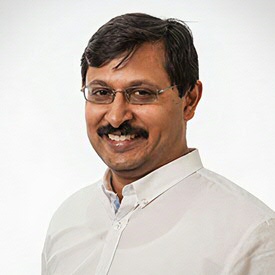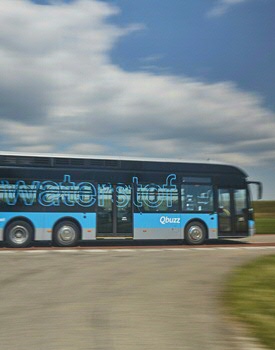Building energy plants that remove greenhouse gases | Interview with Prof. Aravind

Making energy systems more efficient and sustainable has driven the career of Prof. P.V. Aravind. As a student, it led him to come to Europe to study for an MSc at the University of Oldenburg (Germany) and a PhD at Delft University of Technology, where he subsequently started his own research group. In September 2019, he moved to the University of Groningen to work, among other projects, on reversible fuel cells that can convert fuel into electricity and vice versa. ‘My dream is to create negative emission power plants and reversible fuel cells are helpful in many ways.’
Imagine a power plant that converts waste material from forests into electricity while storing carbon – but that could also convert carbon dioxide from the atmosphere into fuel, chemicals and plastics, using surplus wind and solar electricity. Such a plant that works both ways, using fuel cells, could become a reality very soon, says Aravind. ‘All the components are more or less there, we just need to make them more efficient, long-lasting and integrate them into a single system,’ he explains.

A lot of wind energy
At Delft University of Technology, he set up a group that works on realizing such negative emission plants that actually remove greenhouse gases from the atmosphere. So, why did he move to Groningen? ‘I think this is the logical place to eventually construct a reversible negative emission power plant. There is a lot of wind energy, it has become the flagship region for hydrogen and there is a distribution system for gas.’ Furthermore, the fuel cells that Aravind is going to study need input from materials science, which the University of Groningen is well known for. ‘And balancing different energy forms in an electricity grid requires control systems, which is also a prominent topic at the Faculty of Science and Engineering,’ says Aravind.
Fuel cells
He has been appointed to the chair formerly held by Prof. Howard Levinsky, who studied gas combustion. ‘We are now in the process of redesigning the laser lab that he used in his research to study electrochemical oxidation at the electrodes of fuel cells.’ A postdoctoral researcher and a technician will join Aravind in the coming months to start the conversion. A PhD student and Master’s students will follow soon after. ‘We will study, for example, how and where fuel is oxidized in the cell and the temperature distribution inside the cells. All this is to make them safer and more efficient.’ These fuel cells usually run on hydrogen or hydrogen carriers. And they can both burn hydrogen to produce electricity and use electricity to generate hydrogen, and even combine this with carbon dioxide to produce chemicals, plastics and fuels.
Natural disasters
More generally speaking, Aravind’s work will focus on the overlap between thermodynamics, power plant engineering and electrochemical systems. The field that he studies has developed rapidly over the last decade or so. But speed is important, says Aravind: ‘If natural disasters driven by climate change increase, mankind has to start taking carbon out of the atmosphere.’ Negative emission power plants will be one part of the solution – planting more trees will also be necessary. And those extra trees will produce waste, such as pruning offcuts, which could then be used for energy production. ‘We cannot afford to gamble on just one technology,’ Aravind emphasizes. ‘We need all the options that we can find.’
Train technicians
Aside from his research, Aravind is also involved in teaching. ‘We are setting up a track in process design for energy systems for the Master’s programme in Mechanical Engineering at the UG.’ And Aravind is collaborating with both the Hanze University of Applied Sciences and Noorderpoort College to train technicians needed in the energy transition. The Hanze University’s EnTranCe facility (the Energy Transition Centre, a testing ground for applied research in the field of energy transition at the Zernike Campus) plays a role in Aravind’s plans for both teaching and research. ‘The developments in energy transition are happening so fast that we had to devise a new way of training,’ he explains. The first part of the course at the Hanze university of applied sciences is online and includes serious games. For the second part, the programme uses a travelling laboratory to train practical skills. ‘My aim is to start a similar project for university-level training; that is something I am working on now.’
This article has been taken from our alumni magazine Broerstraat 5. Text: René Fransen
| Last modified: | 25 August 2020 3.23 p.m. |
More news
-
24 March 2025
UG 28th in World's Most International Universities 2025 rankings
The University of Groningen has been ranked 28th in the World's Most International Universities 2025 by Times Higher Education. With this, the UG leaves behind institutions such as MIT and Harvard. The 28th place marks an increase of five places: in...
-
05 March 2025
Women in Science
The UG celebrates International Women’s Day with a special photo series: Women in Science.
-
16 December 2024
Jouke de Vries: ‘The University will have to be flexible’
2024 was a festive year for the University of Groningen. In this podcast, Jouke de Vries, the chair of the Executive Board, looks back.
